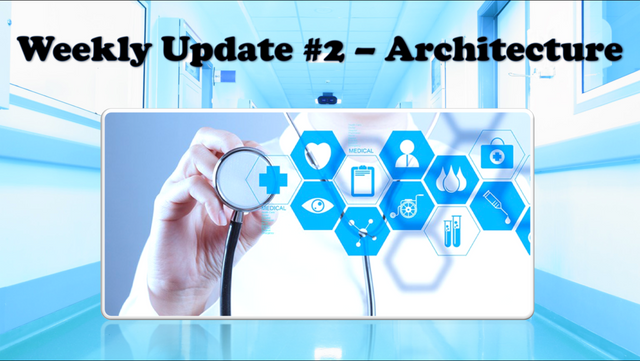
This past Tuesday, I held my first meeting with developers from the BitShares team as well as with my colleague from IBM, Ian Balina. We managed to find a great room on the GWU campus in Washington D.C. – complete with plenty of seats, a podium and several whiteboards. We spent several hours mapping out the initial architecture on two whiteboards which you can see below:
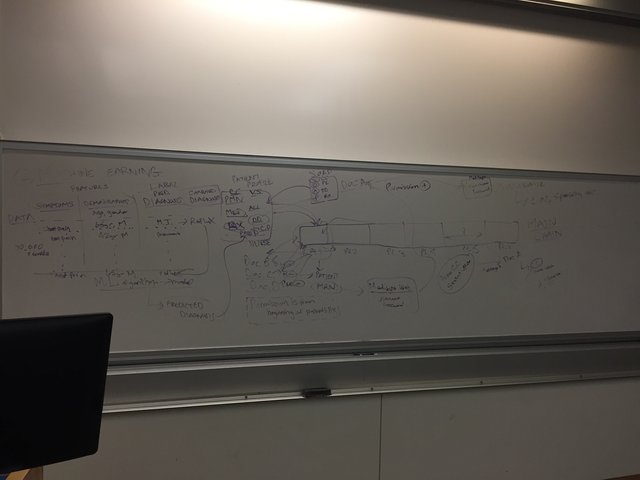
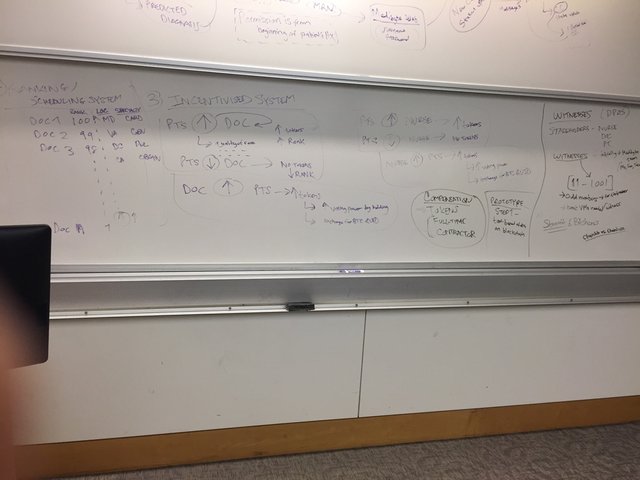
The first board detailed the most essential aspects of our Decentralized EHR – loading of patient records on the blockchain, how the patient will use the system and how the system’s machine learning model will calculate predicted diagnoses for new patients. The second board dealt with the more advanced features of the system such as the performance-based incentivized platform, the ranking/scheduling system and a brief description of witnesses for our Delegated Proof of Stake (DPOS) blockchain solution.
Well aware that you guys will be unable to read most of what’s written on both boards, I reviewed the two snapshots when I got home and later reproduced the diagrams to make them look more readable and aesthetically pleasing.
I will devote the following post to detailing the initial architecture of the system with the newly reproduced diagrams. So sit back, grab a notebook if you want to take notes and enjoy!
Loading of patient records
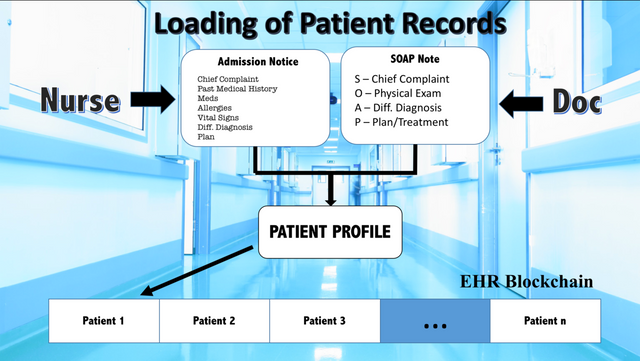
When a new patient is admitted to the hospital or rehab center or visits a clinic for a checkup, the nurse is the first person to create a new profile for the patient. Examples of information initially entered into the profile include Chief Complaint, Past Medical History, Medications, Allergies, Vital Signs, Differential Diagnosis and Plan.
The physician will usually see the patient afterwards and will prepare their own SOAP (Subjective-Objective-Assessment-Plan) note which will include a description of the patient’s Chief Complaint, Physical Exam, Differential Diagnosis and Plan/Treatment. This SOAP note will also be loaded into the patient’s profile on the blockchain.
Finally whenever the patient has access to this system, they will use the Medical Record Number (MRN) to access the system and create a unique username and password. With these login credentials, a patient now has 100% open access to their medical record at any time from anywhere in the world.
How a patient uses the system
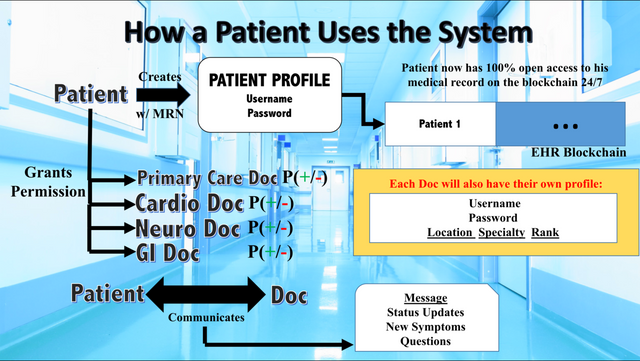
As the sole owner of their medical record, the patient can now grant permission to their physician(s) to see their medical record at any time from anywhere in the world. If the patient only has a Primary Care Physician (PCP), they can simply give permission to this PCP to view their entire medical history. If the patient is currently being seen by other specialists too, such as cardiologists, neurologists, gastroenterologists, etc., the patient can also grant permission to these specialists to allow them to view their entire medical history.
Each physician will also have their own profile on the system which will be accessed by their own unique username and password and will contain information such as their location, specialty and rank.
At any time from anywhere in the world, a patient can communicate with their physicians (those who have permission to view the medical record) by sending messages over the blockchain, such as status updates on their condition, new symptoms and questions. The physician can receive, view and respond to these messages at any time.
At the conclusion of care – when a patient is discharged from the hospital or rehab or receives treatment at the clinic – the patient can rescind permission for specific doctors or for all the doctors currently accessing their medical record. For example, after the patient is discharged home, they can continue to only communicate with their PCP and thus rescind permission for their other specialists – cardiology, neurology, GI, etc. Thus you will notice in the diagram above that each doctor has a P+ (permission granted) or a P – (permission rescinded).
A Machine Learning model for computing predicted diagnoses
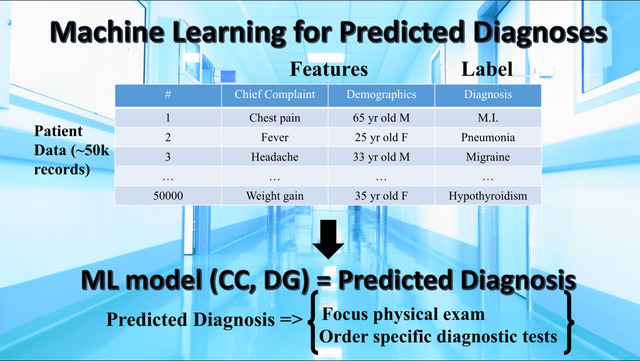
Our Decentralized EHR system will have a built-in machine learning (ML) model that will compute predicted diagnoses for new patients. This ML model will be trained with preexisting medical data - thousands of historical patient records with fields for symptoms, demographics (age and gender) and diagnosis. Thus, the features to be analyzed by the ML model will be the chief complaint (CC) and demographics (DG) and the label to be predicted will be the diagnosis (D).
For new patients added to the EHR blockchain, their chief complaint and demographics will be passed to the ML model, which will compute a predicted diagnosis for each new patient. The physician can then use this predicted diagnosis to focus their physical exam and determine the most appropriate diagnostic tests to be ordered.
Finally, the physician will make their own diagnosis – the computed diagnosis – which will be subsequently added to the database powering the ML model, in order to further improve the accuracy of future predicted diagnoses.
This ML function will be on a system separate from the EHR blockchain in order to spare the main chain from getting bogged down by excessive computations and data storage. However, the output of the ML function – the predicted diagnosis – will in fact be stored on the main chain.
A performance-based incentivized system
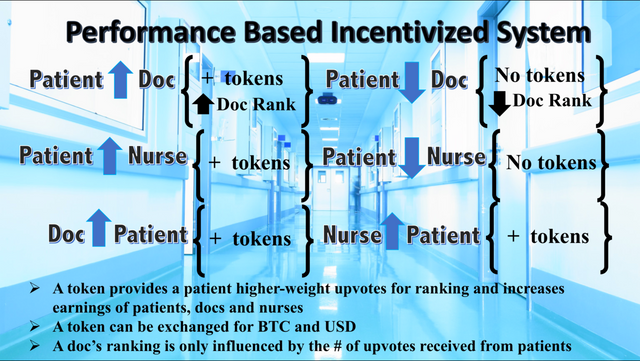
All patients will be able to upvote or downvote their physicians based on the quality of care, level of comfort and other criteria important to the patient for assessing their hospital/rehab stay or clinic visit.
Each upvote by a patient will reward a physician with tokens as well as increase their rank on the system. The token can be used by the physician to increase their earnings, since it can be traded on exchanges for Bitcoin and USD.
Each downvote by a patient will not reward a physician with any tokens and will decrease their rank on the system.
All patients can also upvote or downvote nurses based on the quality of care, level of comfort and other criteria relevant to the patient for assessing their interactions with the nurse in the hospital, rehab or clinic.
Each upvote by a patient will reward a nurse with tokens, which will increase their earnings. Each downvote by a patient will not reward a nurse with any tokens. Since nurses are not ranked on the system, each upvote and downvote by a patient solely controls the amount of tokens they can earn.
Nurses and physicians can also upvote patients based on cooperation, medication compliance, good behavior and other criteria decided by these healthcare practitioners to assess their interactions with the patient.
Each upvote by a nurse or physician will reward a patient with tokens, which will increase their earnings. A patient however cannot be downvoted by a nurse or physician. If a patient is ever uncooperative, noncompliant with medications, exhibits bad behavior, etc., a nurse and physician can simply choose not to upvote the patient.
A token increases the earnings of patients, doctors and nurses on the platform since they can be exchanged for Bitcoin and USD. A token also provides a patient with higher-weight upvotes; the amount of tokens held by a patient is directly proportional to their voting power on the platform. Thus, a patient can choose to hold tokens on the system (instead of cashing out to BTC and USD) in order to directly influence the rankings of physicians and earnings of physicians and nurses on the platform.
While tokens are directly tied to a patient’s voting power on the platform, they do not influence physician rankings. Regardless of the amount of tokens possessed by a physician, their ranking on the platform is ONLY influenced by the number of upvotes received from patients.
What’s coming up next?
I hope you noticed that I decided to exclude discussion of the ranking/scheduling system and witnesses from the architecture. These are more advanced considerations that we shall save for a later time especially after we begin development of the prototype. For example, the scheduling system will simply draw data from the physician’s profile – location, specialty and rank – and will order the physicians according to rank in order to allow patients to choose whom to schedule for an appointment.
Thus, the development of the prototype will most likely commence with the first two parts of the architecture – the loading of patient records on the blockchain and the machine learning function. Upon fleshing out the economics of our token in more detail, we can include the incentivized system in our solution and later create the scheduling system.
Now that we have created the initial architecture, the development team is currently working on a plan/roadmap for the prototype. Our goal is to have the prototype completed before November, ideally for a chance to present our project at SteemFest2.
The team will also secure the domain name and website for our project in the coming days. As soon as this is complete, I will officially announce the name of our Decentralized EHR solution and launch a competition to find the best logo right here on Steemit.
We will meet again next week to discuss if there are any modifications/additions to be made to the initial architecture – especially to the first two parts – before starting development of our prototype. Rest assured, I will keep the entire community posted every step of the way right up to our expected launch in November – stay tuned!
Please let me know if you have any questions about our project. If you have experience or know anyone working in the healthcare or blockchain industries, please contact me by either leaving a comment below or emailing me at [email protected].
Until next time, keep acing life!

Thanks for sharing! Storing patients records is a great idea & help people store lengthy medical records on the blockchain. Looking forward to an ICO
Downvoting a post can decrease pending rewards and make it less visible. Common reasons:
Submit
Thanks @tonegreenthumb - stay tuned for more updates on our project and an upcoming announcement later this week/early next week!
Downvoting a post can decrease pending rewards and make it less visible. Common reasons:
Submit
looks interesting @cerebralace . upvoted and resteemed
I will read this again later
Downvoting a post can decrease pending rewards and make it less visible. Common reasons:
Submit
Thanks @araki, I appreciate the resteem! Let me know if you have any questions!
Downvoting a post can decrease pending rewards and make it less visible. Common reasons:
Submit
What happened to you???
Downvoting a post can decrease pending rewards and make it less visible. Common reasons:
Submit
This type of project is why I'm backing bitshares. Great innovations.
Downvoting a post can decrease pending rewards and make it less visible. Common reasons:
Submit
Thank you @answerblack - BitShares has an awesome team and the fastest blockchain in the world!
Downvoting a post can decrease pending rewards and make it less visible. Common reasons:
Submit
hi friend great post i like it
Downvoting a post can decrease pending rewards and make it less visible. Common reasons:
Submit
Thank you @vahidrazavi!
Downvoting a post can decrease pending rewards and make it less visible. Common reasons:
Submit
Please visit my page and write your comment and follow me thanks alot
Downvoting a post can decrease pending rewards and make it less visible. Common reasons:
Submit
This is needed. As long as the patient is first and truly comes first this system will change the industry for good.
Downvoting a post can decrease pending rewards and make it less visible. Common reasons:
Submit
Indeed @aj41, this will be the world's first patient-centric decentralized EHR solution - giving 100% ownership to the patient, saving significant time for the physician and rewarding patients, physicians and nurses for their time, hard work and cooperation.
Downvoting a post can decrease pending rewards and make it less visible. Common reasons:
Submit
This is some great stuff! I like how you can upvote the doctors :) Thanks for sharing. also followed.
Downvoting a post can decrease pending rewards and make it less visible. Common reasons:
Submit
Thanks @bilbotbaggins, you're very welcome!
Downvoting a post can decrease pending rewards and make it less visible. Common reasons:
Submit
Excellent progress! I'm glad to see things being planned so efficiently.
Keep up the good work!
There are a few things that may be important to consider.
Will you be planning specialized infrastructure so emergency departments can quickly and efficiently access critical patient information with optimal realiability?
Would you be designing some feature to allow all current patient records to be periodically stored in a database onsite in case of network outage?
Who will manage the witness nodes? Would it be your organization, or would any of it be managed by the facilities?
You take great care to insure that healthcare personnel are rewarded. Do you have any consideration for other necessary staff members? IT, Maintenance, Etc.
Have you considered integrating a scheduling platform? Perhaps that is a project for a whole new blockchain ;-)
Downvoting a post can decrease pending rewards and make it less visible. Common reasons:
Submit
Thanks for reading @akrid and great questions! Let me see how many of these I can knock out right now since I'll be covering all of these in greater detail in the coming weeks:
The scheduling platform will definitely be a feature of our solution - it will just be a part of a separate network, since the main chain will be designated for patient records and patient-physician communication. As hinted in the article, the scheduling system will allow patients to see a list of all physicians ordered by rank, location and specialty - information which will essentially be retrieved from each doctor's profile.
For now, only the three main users served by the system - nurses, physicians and of course patients will be rewarded by the system. Now if the witnesses voted by the stakeholders happen be IT and other staff members, they will also be rewarded as block validators.
The witness nodes will be managed by witnesses voted in by the stakeholders - patients and physicians. Initially, the witnesses for our solution will be the members of our team. When the system is implemented at hospitals, rehabs and clinics and fully-functional, patients and physicians will be able to vote other people as witnesses, such as IT personnel, engineers, other physicians, etc. Of course for a Graphene blockchain, the minimum number of witnesses will be 11 and the maximum number 1001 - always ensuring that there are an odd number of witnesses for tiebreakers.
A feature to allow backup of patient records in case of network outage is a definite consideration that we will make after we have completed the basic prototype and begin development of the full solution.
Our Decentralized EHR solution will be specifically designed for ease of use by nurses, physicians and patients and will always ensure that critical patient information - vitals, labs, imaging results, meds and orders - are quickly accessed at any time from any place within as well as outside the hospital, especially the emergency department.
If you have any more questions, let me know! We're going to go over all of this in greater detail as we start building the prototype so stay tuned!
Downvoting a post can decrease pending rewards and make it less visible. Common reasons:
Submit
Thanks for taking the time to make such a detailed and complete response.
It seems like you have everything figured out.
Keep up the great work! This is truly the most important project I've ever seen on blockchain, not to mention the one with the most potential.
Downvoting a post can decrease pending rewards and make it less visible. Common reasons:
Submit
You're very welcome @akrid, thank you very much for the questions! I always appreciate your thoughtful comments and support. I will keep you posted on everything - keep the questions coming! ;)
Downvoting a post can decrease pending rewards and make it less visible. Common reasons:
Submit
This post received a 3.3% upvote from @randowhale thanks to @cerebralace! For more information, click here!
Downvoting a post can decrease pending rewards and make it less visible. Common reasons:
Submit
Congratulations @cerebralace! You have completed some achievement on Steemit and have been rewarded with new badge(s) :
Click on any badge to view your own Board of Honor on SteemitBoard.
For more information about SteemitBoard, click here
If you no longer want to receive notifications, reply to this comment with the word
STOPDownvoting a post can decrease pending rewards and make it less visible. Common reasons:
Submit
😘😘😘👍👍
Downvoting a post can decrease pending rewards and make it less visible. Common reasons:
Submit
ما شاء الله اخي راق لي موضوعك
تم متابعتك والتصويت لموضوعك
اتمنى ان تدعمني انا في بداية الركب ههههه
Downvoting a post can decrease pending rewards and make it less visible. Common reasons:
Submit
I follow you. I will help you @bakabou159704
Downvoting a post can decrease pending rewards and make it less visible. Common reasons:
Submit
Cool
Downvoting a post can decrease pending rewards and make it less visible. Common reasons:
Submit